Baldwin "Centipede" Locomotives: Specs, Roster, Photos
Last revised: December 28, 2024
By: Adam Burns
The "Centipede," technically listed by Baldwin as a DR-12-8-3000 or DR-12-8-1500/2, was perhaps the most unique
diesel-electric locomotive concept ever developed.
Constructed during the 1940s, the radical design was more on par with electrics given the Centipede's unique 2-D+D-2 wheel arrangement.
Surprisingly, several units were built for a handful of railroads. Seaboard Air Line is credited with the initial idea for what became the Centipede (so named for its numerous axles).
Overview
As John Kirkland points out in his book, "The Diesel Builders: Volume Three (Baldwin Locomotive Works," SAL management wanted a locomotive with smooth riding characteristics that could produce 6,000 horsepower via two units instead of the conventional three then in production by American Locomotive and Electro-Motive as A-B-A sets.
Today, none of the 52 Centipedes built for Ferrocarriles Nacionales de México (NdeM), Pennsylvania, and Seaboard Air Line are preserved. In addition, the two demonstrators, which never sold, were also scrapped.
From a historical standpoint it is a true shame considering their distinctive nature and importance in diesel locomotive development.
An extant example, especially if one was actually in operable condition, would draw considerable crowds and attention.
Photos
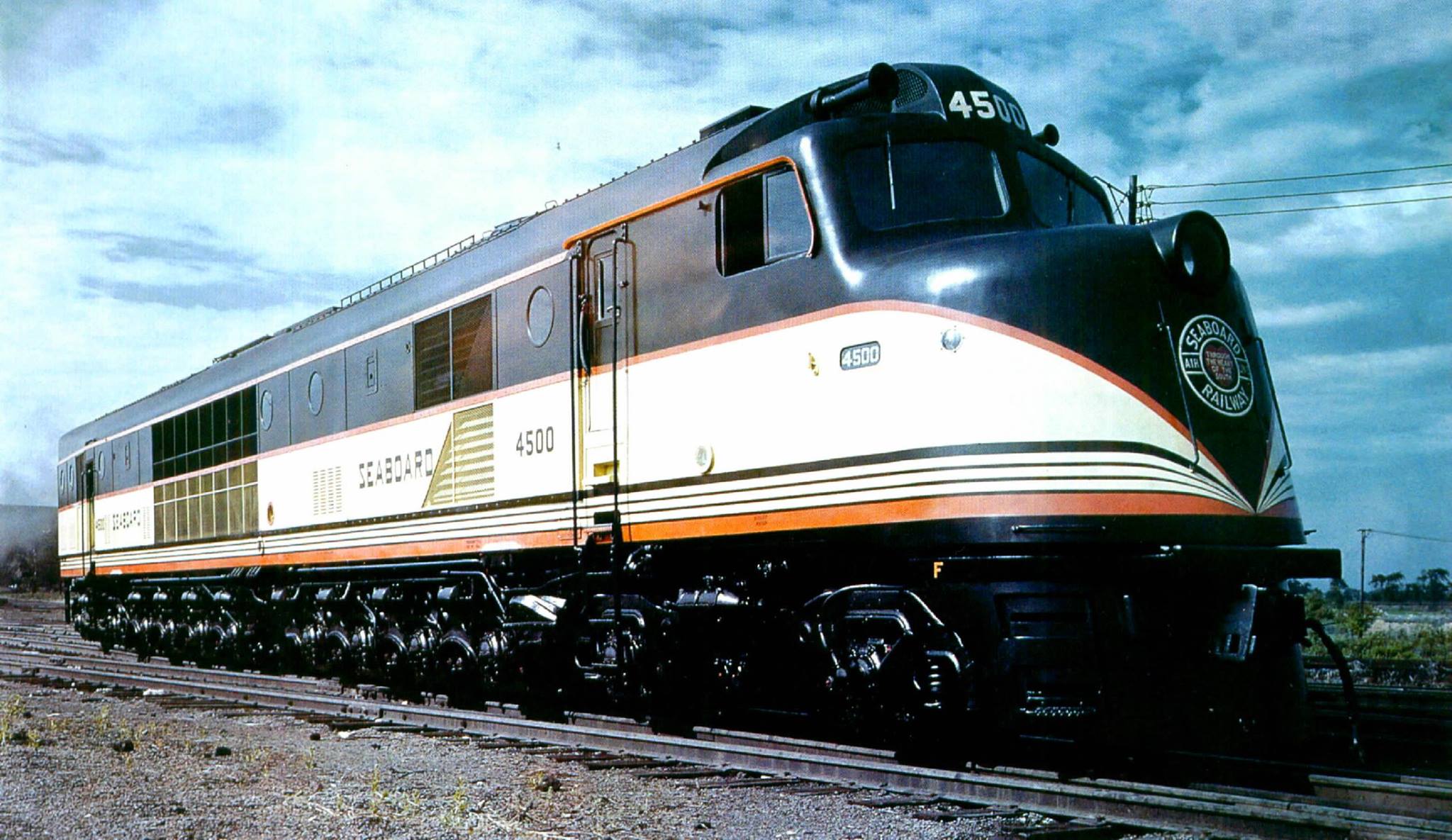 Seaboard Air Line DR-12-8-3000 "Centipede," #4500, is seen here in Florida during early December of 1945, shortly before entering service between Jacksonville and St. Petersburg. This unit was rebuilt from the original #6000 demonstrator.
Seaboard Air Line DR-12-8-3000 "Centipede," #4500, is seen here in Florida during early December of 1945, shortly before entering service between Jacksonville and St. Petersburg. This unit was rebuilt from the original #6000 demonstrator.Contrary to popular belief, the Centipede was not designed as a drag service locomotive. Instead, its heritage can be traced back to the end of World War II and "The Claymont Tests."
In 1945, railroads were looking to complete dieselization of their top passenger trains which, in turn, would allow for faster schedules.
There was only one problem; the heavy wear and tear of the war effort had resulted in many rights-of-way needing significant overhaul.
This deferred maintenance could be felt in the rough ride of four, and even six axle locomotives. To remedy this issue, and simply establish a better ride quality, the Pennsylvania Railroad launched the "Claymont Tests" in Claymont, Delaware.
This electrified test track led to the development of the fabled GG-1, one of the most reliable and smoothest-riding locomotives (diesel, electric, or steam) ever built. Baldwin would go on to produce a majority of these units.
The Seaboard Air Line was particularly interested in the goings-on at Claymont. However, without the funds or interest in upgrading its property to electrification, SAL's management was focused on a diesel-electric variant.
As Mr. Kirkland's book notes, in 1944 Seaboard's brass was touring Baldwin's Eddystone plant when they came across a stored test-bed unit, 2-D+D-2 demonstrator #6000.
This locomotive had originally began development in May, 1940. In 1942, the War Production Board gave the go ahead for its completion.
The locomotive was designed for passenger service from the start; it would incorporate eight, 750 horsepower De La Vergne engines (model 408) for a total of 6,000 horsepower.
Baldwin, however, also had a freight variant drawn up but never actually produced a demonstrator. The locomotive would have boasted 4,500 horsepower but lower gearing for greater tractive effort.
Unfortunately, delays and rising costs led to Baldwin stopping work on #6000 in the spring of 1943 after only four engines had been installed. On May 28th that year she was deemed "complete" and tested on the Pennsylvania, Reading, and Baltimore & Ohio around Philadelphia.
These tests were successful and the locomotive proved an efficient power plant. However, Baldwin realized the design could not make a profit in its as-designed configuration.
Essentially, it was "too powerful," lacking the redundancy and flexibility of similar 6,000 horsepower passenger locomotives offered by Electro-Motive and Alco as stand-alone, A-B-A configurations (2,000 horsepower each).
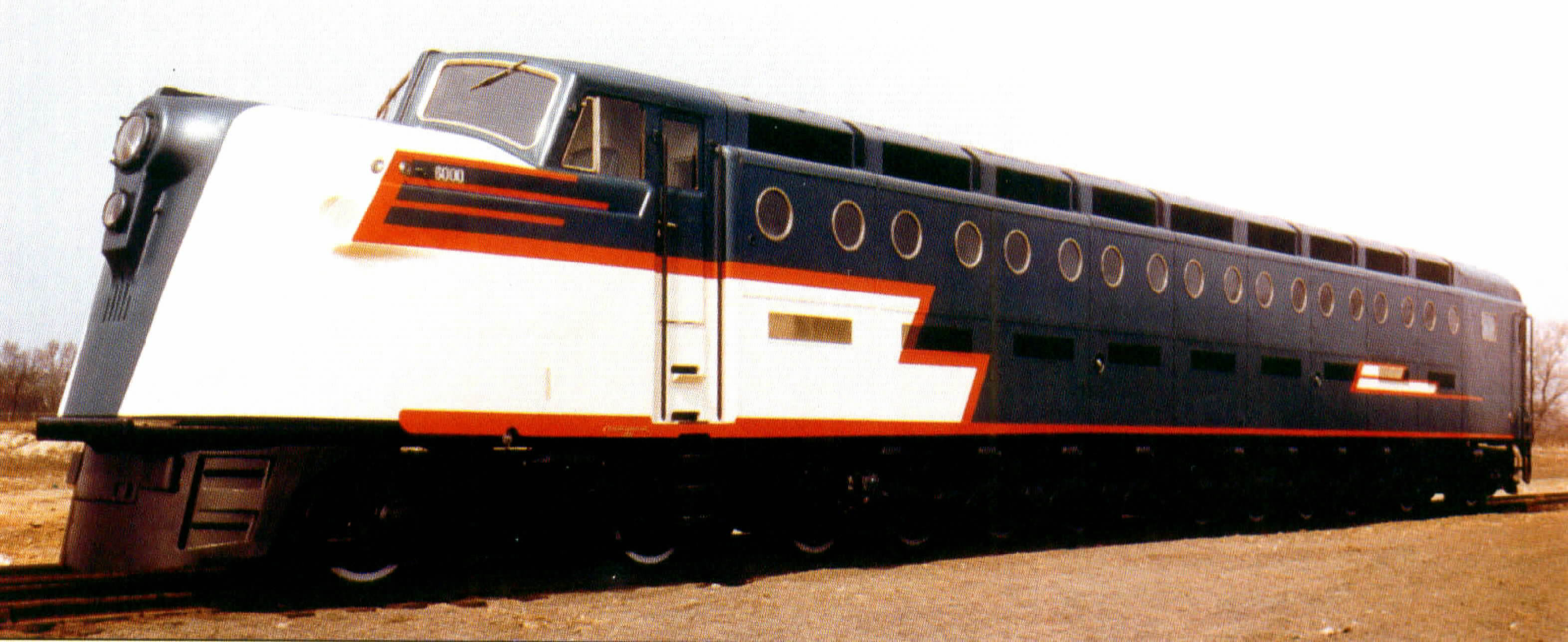 Baldwin's original, experimental DR-12-8-3000 "Centipede," #6000, manufactured in 1943 and designed to carry eight, 750-horsepower De La Vergne engines. Only four were ever installed and the unit was later rebuilt as the original Centipede demonstrator, which became Seaboard Air Line #4500.
Baldwin's original, experimental DR-12-8-3000 "Centipede," #6000, manufactured in 1943 and designed to carry eight, 750-horsepower De La Vergne engines. Only four were ever installed and the unit was later rebuilt as the original Centipede demonstrator, which became Seaboard Air Line #4500.2-D+D-2 Demonstrator #6000
| Began Production | 5/27/1940 (Date the locomotive's eight engines were ordered.) |
| Date Completed | 5/28/1943 |
| Baldwin Class | 4-8+8-4 750/8 DE1 |
| Construction Number | 64639 |
| Engine | Model 408 (8 at 750 HP each) |
| Engine Builder | De La Vergne |
| Supercharger | Roots |
| Steam Generator | Oil-Fired |
| Horsepower | 6000 |
| RPM | 1050 |
| Carbody Styling | Baldwin |
| Length (Between Coupler Pulling Faces) | 91' 6" |
| Height (Top Of Rail To Top Of Cab) | 15' |
| Width | 10' 4 ¾" |
| Weight | 685,000 Lbs |
| Trucks | 2-D+D-2 |
| Wheel Size | 40" |
| Traction Motors | 370A (8), Westinghouse |
| Traction Generator | 488C, Westinghouse |
| Auxiliary Generator | YG37B, Westinghouse |
| Gear Ratio | 25:54 |
| Tractive Effort Rating | 45,000 Lbs at 39 MPH. |
| Top Speed | 120 MPH |
As such, Baldwin abandoned the concept and placed #6000 in storage until SAL management came across the locomotive the following year.
Seaboard was interested in a slightly modified version that would feature the same wheel arrangement for a smoother ride, only de-rated as 3,000 horsepower units operating in tandem.
In this way, as individual units or semi-permanently coupled, Seaboard believed operating costs could be reduced by eliminating the need for an additional locomotive.
Baldwin's new test-bed design used its updated 608SC power plants. The prototype was actually built from #6000 using its head-end cab, frame, and running gear.
When completed on December 3, 1945 the new locomotive, given class DR-12-8-1500/2, initially retained its original demonstrator number, 6000, before being renumbered as Seaboard Air Line #4500.
It entered passenger service on December 13, 1945 between Jacksonville and St. Petersburg, Florida and with a gear ratio of 21:58 could operate at speeds up to 93.5 mph.
Seaboard was satisfied with the result and ordered thirteen more Centipedes.
In railroad parlance, the 2-D+D-2 arrangement is based from the electric classification system where:
- "2" refers to two unpowered axles front and aft .
- "D" refers to four powered axles whereby “A” equals one powered axle, “B” equals two powered axles, “C” equals three powered axles, and so on.
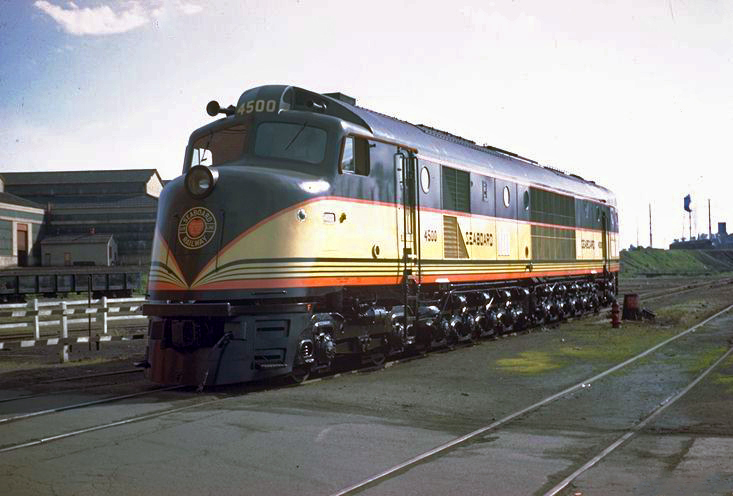 A Baldwin photo of new Seaboard Air Line DR-12-8-3000 #4500 at the manufacturer's plant in Eddystone, Pennsylvania following its completion on December 3, 1945. It entered service between Jacksonville-St. Petersburg, Florida on December 13, 1945.
A Baldwin photo of new Seaboard Air Line DR-12-8-3000 #4500 at the manufacturer's plant in Eddystone, Pennsylvania following its completion on December 3, 1945. It entered service between Jacksonville-St. Petersburg, Florida on December 13, 1945.Using Baldwin's rating system, however, the Centipede was a DR-12-8-3000. Breaking down the designations:
- DR referred to Diesel Road unit
- The first number, 12, was the designation of twelve overall axles.
- The second number, 8, was the designation of eight powered traction motors.
- 3,000 stood for the horsepower rating (in later models Baldwin would shorten the horsepower number to include only the first two digits of the rating; so a 2,000 horsepower unit like the "Babyface" model would be DR6-4-20)
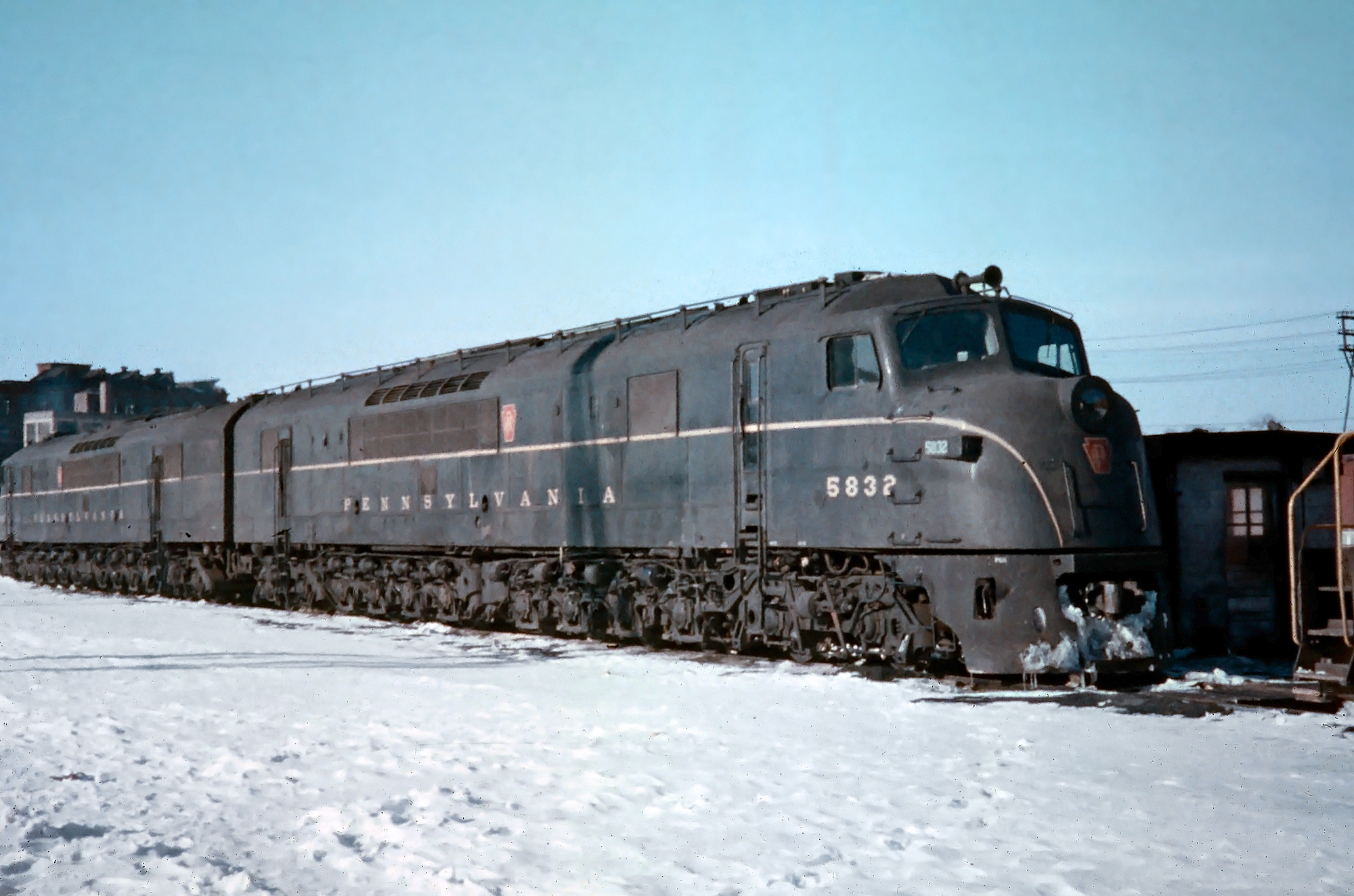 A Pennsylvania DR-12-8-3000 set, with #5832 closest to the photographer, are seen here at West Philadelphia, Pennsylvania on January 7, 1958. American-Rails.com collection.
A Pennsylvania DR-12-8-3000 set, with #5832 closest to the photographer, are seen here at West Philadelphia, Pennsylvania on January 7, 1958. American-Rails.com collection.Other railroads soon took notice of the new concept and interest was immediate. Baldwin's ever-loyal customer, the Pennsylvania Railroad, ordered 12, semi-permanently coupled pairs for what was actually a total of 24 individual units (later renumbered individually as 5811-5834).
Each Centipede cost $287,250 earning Baldwin $6.9 million from PRR's order alone. The first units went into service on April 17, 1947. They were equipped with 22:57 gearing and could fly, boasting a top speed of 100 mph.
There were also orders placed by Ferrocarriles Nacionales de México (National Railways of Mexico) for 14 units and, finally, Union Pacific ordered a pair that was later canceled.
Baldwin went on to complete what was to become Union Pacific #998-999 in March, 1948 and showcased them as demonstrators #6000 (2nd) and #6001. They were never sold and eventually parted out for other projects.
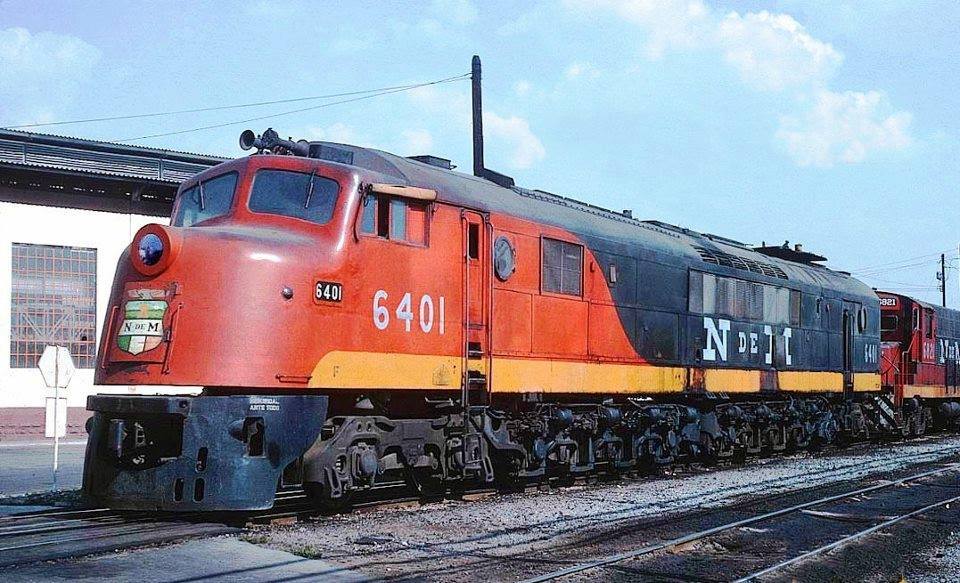 Ferrocarriles Nacionales de México (NdeM) DR-12-8-3000 "Centipede" #6401, out-shopped by Baldwin in early 1948. César Martínez Ávila collection.
Ferrocarriles Nacionales de México (NdeM) DR-12-8-3000 "Centipede" #6401, out-shopped by Baldwin in early 1948. César Martínez Ávila collection.Kirkland makes a strong case that the Centipedes were not a failed design and proved satisfactory for the service they were intended.
In addition, contrary to what is often stated in railfan circles, Baldwin offered these, and all locomotives, with optional dynamic brakes and multiple-unit (MU) capability.
As it turns out, PRR's complaint that the locomotives tracked poorly and suffered derailments was largely a result of the railroad operating them in a capacity for which they were not ended, as pushers in freight service handling westbound consists over Horseshoe Curve between Altoona and Gallitzin, Pennsylvania (in 1958 many were transferred as helpers between Altoona-Enola while at least one worked as the Paoli pusher).
The Pennsy had originally acquired its fleet of 12 pairs (24 units) in 1947-1948, classified as the BP60, with intentions of the locomotives leading its premier passenger trains.
However, the railroad quickly discovered the locomotives suffered from reliability issues in the way of electric and lubrication problems which sometimes led to engine fires. Within a few years they were transferred off these trains and reclassified as BH50.
By 1951, PRR dropped their drawbars for couplers and re-geared the locomotives for freight operation; at a 15:63 ratio they could operate at speeds up to 65 mph providing 85,600 pounds of continuous tractive effort at 10.5 mph.
The Centipedes were designed to operate at the head-end of any consist. By placing them at the center, or rear, of a freight train they exerted far too much torque and power for the cars, or outside rail of a curve, to handle.
In this case there were frequent derailments and jack-knifing incidents. Interestingly, during the time Centipedes led PRR passenger trains, no such issues were experienced.
In addition, the Seaboard never suffered similar issues since their fleet had never been used in pusher service.
The PRR also complained about the difficulty in replacing brake shoes. Interestingly, the Pennsy operated a large fleet of various straight-electrics featuring a similar number of axles, such as its large fleet of GG-1's.
These locomotives never had an issue with brake shoes. In this case, the railroad boasted maintenance shops with inspection pits to easily replace the shoes and carry out other work on the running gear.
The PRR never built such facilities for the Centipedes; the Seaboard did, and never had problems with shoe replacement.
While most of the supposed issues with the DR-12-8-3000 have largely been either railfan conjecture or dispelled myths, the locomotive was not without its faults.
The Centipede was, quite frankly, a special service design. As such, its performance declined when not used as intended; in this case at the head-end of passenger trains. In addition, it also suffered from reliability problems as previously mentioned on the PRR in passenger assignments.
Baldwin had spent a great deal of research and development on the Centipede, and also had the added advantage of workable data with demonstrator tests and units purchased by the above-mentioned railroads.
Given enough time, the builder would have almost certainly corrected any issues of the Centipede being used in freight applications, if any railroad had expressed interest.
From a historic standpoint, the Centipede's supposed shortfalls have only been noted by railfans; many railroads at the time were actually quite interested in the design.
John Kirkland's Comments
As someone who worked at Baldwin from 1940 until the company exited locomotive manufacturing, Kirkland understood the company's operations and history better than most, and certainly better than any railfan/train enthusiast. His comments on the Centipede was as follows:
"Baldwin considered the Centipede an optional model which was offered as an alternate to conventional locomotive models where track conditions made such a wheel arrangement highly desirable.
Baldwin felt there might be a demand for this locomotive equipped with traction motors on all 12 axles for use in heavy drag operations. Had it been so equipped it would have, in effect, functioned like a six traction motored 3,000 horsepower road switcher coupled to a six traction motored slug.
This was one of the premises that prompted placing demonstrators numbers 6000 and 6001 on the road equipped with 15:63 freight gearing. In this manner the general design of this model, together with its unexcelled tracking characteristics, could be observed by potential customers, even though it was equipped with only eight traction motors.
The reception given by the railroads in the 1945-1950 period to these Baldwin Centipedes was essentially the same as that given to the big high-horsepower dual engine equipped locomotives that were introduced to the trade again in the mid-1960s by Alco, EMD, and GE.
Summed up in a few words, they did not possess the flexibility that was inherent when obtaining the same horsepower through the use of two smaller locomotives operating in multiple unit. Whereas there were three purchasers of Centipedes, 20 years later there were only two purchasers of big dual engine equipped locomotives.
One of the three articles on Centipedes that appears in a well read railfan magazine was devoted to discussing the "Engineering faux pas" built into the Pennsylvania Railroad's 12 pairs of locomotives.
Adverse comment was offered about their poor tracking characteristics; lack of dynamic brake; inability to multiple with any other type of locomotive of any make other than themselves, and then only when coupled back-to-back; difficulty of changing out worn brake shoes; problems with the engines due to operation over mountainous terrain; and excessive piston ring and cylinder liner wear, together with excessive lube oil consumption.
This type of negative commentary would have been spoiled had the facts relating to these purported deficiencies been presented. To support this assertion, some facts, rather than opinions, will be offered."
Kirkland goes on to dispel myths related to the locomotive's poor track record in these areas. It is a fascinating read and highly recommended.
Finally, Baldwin had even collaborated with the Denver & Rio Grande Western on a dual-application, freight version that could operate as either a diesel or straight electric.
Gearing Options
| Gear Ratio | Maximum Speed | Continuous Tractive Effort (Lbs) | Continuous TE Rating Speed |
|---|---|---|---|
| 15:63 | 65 | 85,600 | 10.5 |
| 19:60 | 82 | 64,400 | 14.0 |
| 21:58 | 93.5 | 56,200 | 16.0 |
| 22:57 | 100 | 52,800 | 17.6 |
| 23:56 | 106 | 49,600 | 18.8 |
| 25:54 | 120 | 44,000 | 20.6 |
Data Sheet and Specifications
Original Unit
(Seaboard Air Line #4500)
| Date Completed | 12/3/1945 |
| Baldwin Class | DR 12-8-1500/2 SC-1 |
| Construction Number | 71579 |
| Engine | 608SC (2) |
| Engine Builder | De La Vergne |
| Supercharger | Roots |
| Steam Generator | Oil-Fired |
| Horsepower | 3000 |
| Carbody Styling | Baldwin |
| Length (Between Coupler Pulling Faces) | 91' 6" |
| Height (Top Of Rail To Top Of Cab) | 15' |
| Width | 10' 4 ¾" |
| Weight | 595,000 Lbs |
| Trucks | 2-D+D-2 |
| Wheel Size | 40" |
| Traction Motors | 370F (8), Westinghouse |
| Traction Generator | 471A, Westinghouse |
| Auxiliary Generator | YG42A, Westinghouse |
| Gear Ratio | 21:58 |
| Tractive Effort Rating | 56,200 Lbs at 16 MPH. |
| Top Speed | 93.5 MPH |
Cataloged Model
| Entered Production | 12/3/1945 (Seaboard Air Line #4500) |
| Years Produced | 12/3/1945 - 7/20/1948 |
| Baldwin Class | DR 12-8-1500/2 SC-1 |
| Engine | 608SC (2) |
| Engine Builder | De La Vergne |
| Supercharger | Roots |
| Steam Generator | Oil-Fired |
| Horsepower | 3000 |
| Carbody Styling | Baldwin |
| Length (Between Coupler Pulling Faces) | 91' 6" |
| Height (Top Of Rail To Top Of Cab) | 15' |
| Width | 10' 4 ¾" |
| Weight | 595,000 Lbs |
| Trucks | 2-D+D-2 |
| Wheel Size | 42" |
| Traction Motors | 370F (8), Westinghouse |
| Traction Generator | 471A, Westinghouse |
| Auxiliary Generator | YG42A, Westinghouse |
| Gear Ratio | Optional (See above table.) |
Production Roster
Total Built = 54
| Owner | Road Number | Baldwin Serial Number | Construction Number | Completion Date |
|---|---|---|---|---|
| Seaboard Air Line | 4500 | 1 | 71579 | 12/3/1945 |
| Ferrocarriles Nacionales de México | 6400 | 2 | 72672 | 4/15/1947 |
| Ferrocarriles Nacionales de México | 6401 | 3 | 72673 | 1/10/1948 |
| Ferrocarriles Nacionales de México | 6402 | 4 | 72674 | 4/21/1948 |
| Ferrocarriles Nacionales de México | 6403 | 5 | 72675 | 5/4/1948 |
| Ferrocarriles Nacionales de México | 6404 | 6 | 72676 | 5/9/1948 |
| Ferrocarriles Nacionales de México | 6405 | 7 | 72677 | 5/14/1948 |
| Ferrocarriles Nacionales de México | 6406 | 8 | 72678 | 5/21/1948 |
| Ferrocarriles Nacionales de México | 6407 | 9 | 72679 | 5/31/1948 |
| Ferrocarriles Nacionales de México | 6408 | 10 | 72680 | 6/13/1948 |
| Ferrocarriles Nacionales de México | 6409 | 11 | 72681 | 7/8/1948 |
| Ferrocarriles Nacionales de México | 6410 | 12 | 72682 | 7/8/1948 |
| Ferrocarriles Nacionales de México | 6411 | 13 | 72683 | 7/9/1948 |
| Ferrocarriles Nacionales de México | 6412 | 14 | 72684 | 7/18/1948 |
| Ferrocarriles Nacionales de México | 6413 | 15 | 72685 | 7/20/1948 |
| Baldwin Locomotive Works | 6000* | 16 (2nd) | 73129 | 3/16/1948 |
| Baldwin Locomotive Works | 6001* | 17 | 73130 | 3/16/1948 |
| Pennsylvania | 5823A1 | 18 | 73131A1 | 4/17/1947 |
| Pennsylvania | 5823A2 | 19 | 73131A2 | 4/17/1947 |
| Seaboard Air Line | 4501 | 20 | 73141 | 3/15/1947 |
| Seaboard Air Line | 4502 | 21 | 73142 | 4/9/1947 |
| Seaboard Air Line | 4503 | 22 | 73143 | 4/22/1947 |
| Seaboard Air Line | 4504 | 23 | 73144 | 5/11/1947 |
| Seaboard Air Line | 4505 | 24 | 73145 | 5/18/1947 |
| Pennsylvania | 5824A1 | 25 | 73377A1 | 5/10/1947 |
| Pennsylvania | 5824A2 | 26 | 73377A2 | 5/10/1947 |
| Pennsylvania | 5825A1 | 27 | 73378A1 | 6/15/1947 |
| Pennsylvania | 5825A2 | 28 | 73378A2 | 6/15/1947 |
| Pennsylvania | 5826A1 | 29 | 73379A1 | 9/5/1947 |
| Pennsylvania | 5826A2 | 30 | 73379A2 | 9/5/1947 |
| Pennsylvania | 5827A1 | 31 | 73380A1 | 10/15/1947 |
| Pennsylvania | 5827A2 | 32 | 73380A2 | 10/15/1947 |
| Pennsylvania | 5828A1 | 33 | 73381A1 | 11/15/1947 |
| Pennsylvania | 5828A2 | 34 | 73381A2 | 11/15/1947 |
| Pennsylvania | 5829A1 | 35 | 73382A1 | 12/20/1947 |
| Pennsylvania | 5829A2 | 36 | 73382A2 | 12/20/1947 |
| Pennsylvania | 5830A1 | 37 | 73383A1 | 1/17/1948 |
| Pennsylvania | 5830A2 | 38 | 73383A2 | 1/17/1948 |
| Pennsylvania | 5831A1 | 39 | 73384A1 | 1/31/1948 |
| Pennsylvania | 5831A2 | 40 | 73384A2 | 1/31/1948 |
| Pennsylvania | 5832A1 | 41 | 73385A1 | 2/7/1948 |
| Pennsylvania | 5832A2 | 42 | 73385A2 | 2/7/1948 |
| Pennsylvania | 5833A1 | 43 | 73386A1 | 2/18/1948 |
| Pennsylvania | 5833A2 | 44 | 73386A2 | 2/18/1948 |
| Pennsylvania | 5834A1 | 45 | 73387A1 | 2/28/1948 |
| Pennsylvania | 5834A2 | 46 | 73387A2 | 2/28/1948 |
| Seaboard Air Line | 4506 | 47 | 73146 | 6/10/1947 |
| Seaboard Air Line | 4507 | 48 | 73147 | 7/26/1947 |
| Seaboard Air Line | 4508 | 49 | 73390 | 9/25/1947 |
| Seaboard Air Line | 4509 | 50 | 73391 | 9/28/1947 |
| Seaboard Air Line | 4510 | 51 | 73392 | 11/22/1947 |
| Seaboard Air Line | 4511 | 52 | 73393 | 12/4/1947 |
| Seaboard Air Line | 4512 | 53 | 73394 | 12/28/1947 |
| Seaboard Air Line | 4513 | 54 | 73395 | 1/4/1948 |
* Sold to Union Pacific as #998-999 but order was cancelled. The units became demonstrators #6000-6001 and were ultimately never sold.
As the Centipede was in production, the D&RGW took interest in the locomotive and contemplated electrifying its Moffatt Route from Denver to Bond, Colorado via Moffat Tunnel (129 miles), as well as 54-miles in Utah between Thistle and Helper.
The idea was to eliminate the need for helpers and allow these locomotives to operate the length of the railroad without the need of changing or swapping units
Somewhat similar to EMD's later FL9 concept, the Baldwin/Westinghouse locomotive was to feature all-powered axles in electrified territory (B-D+D-B) whereby the leading and trailing axles would not be powered in the diesel-electric configuration.
The locomotives would boast 6,000 horsepower as individual units, or 12,000 horsepower in pairs. It was a fascinating concept but ultimately never adopted.
There were many reasons why, but at the forefront was competitive headbutting between Westinghouse/Baldwin and American Locomotive/General Electric.
The latter, which would collaborate on the project, felt it would largely benefit Westinghouse/Baldwin since they would be the primary manufacturers of the locomotive.
Service History
Interestingly, despite their problems, the Centipedes remained in service on the Pennsy and Seaboard for nearly 15 years while NdeM retained theirs until 1971 after returning them to Baldwin in 1953 for overhauls and upgrades.
Before all units were retired by 1964, the PRR seriously considering rebuilding its Centipede fleet into straight electrics by stripping their prime movers and replacing the interior compartments with transformers and other electrical gear.
Ultimately, Great Northern was disposing of electric locomotives in the mid-1950s after de-energizing operations through Cascade Tunnel and PRR subsequently acquired several of these units.
Sources
- Brown, Charles A. "The Centipede Connection - 1: From Essl's effort to Seaboard's Solution." Trains Magazine, Volume #42, Issue #7. May, 1982; Pages 38-45.
- Douglas, Kenneth L. "The Centipede Connection - 2: The Mexican Experience, Low Performance At High Altitude." Trains Magazine, Volume #42, Issue #7. May, 1982; Pages 46-47.
- Schafer, Mike and Solomon, Brian. Pennsylvania Railroad. Osceola: MBI Publishing, 1997.
- Kirkland, John F. Diesel Builders, The: Volume Three, Baldwin Locomotive Works. Pasadena: Interurban Press, 1994.
- Pinkepank, Jerry A. Diesel Spotter's Guide. Milwaukee: Kalmbach Publishing Company, 1967.
- Solomon, Brian. Baldwin Locomotives. Minneapolis: Voyageur Press, 2009.
- Volkmer, William. "The Centipede Connection - 3: Personality on the Pennsy, Why Baldwin's biggest was my favorite diesel." Trains Magazine, Volume #42, Issue #7. May, 1982; Pages 48-50.
Recent Articles
-
Kentucky Dinner Train Rides In Bardstown!
Jan 13, 26 01:14 PM
The essence of My Old Kentucky Dinner Train is part restaurant, part scenic excursion, and part living piece of Kentucky rail history. -
Kansas Dinner Train Rides In Abilene!
Jan 13, 26 12:44 PM
If you’re looking for a heritage railroad that feels authentically Kansas—equal parts prairie scenery, small-town history, and hands-on railroading—the Abilene & Smoky Valley Railroad (A&SV) delivers. -
Michigan ~ Murder Mystery ~ Dinner Train Rides
Jan 13, 26 11:24 AM
Among the lesser-known treasures of this state are the intriguing murder mystery dinner train rides—a perfect blend of suspense, dining, and scenic exploration. -
Virginia's - Murder Mystery - Dinner Train Rides
Jan 13, 26 11:11 AM
Among the state's railroad attractions, murder mystery dinner trains stand out as a captivating fusion of theatrical entertainment, fine dining, and scenic travel. -
Arizona Dinner Train Rides At The Grand Canyon!
Jan 13, 26 10:59 AM
While the Grand Canyon Railway does not offer a true, onboard dinner train experience it does offer several upscale options and off-train dining. -
Georgia Dinner Train Rides In Nashville!
Jan 13, 26 10:27 AM
If you’ve ever wished you could slow down, trade traffic for jointed rail, and let a small-town landscape roll by your window while a hot meal is served at your table, the Azalea Sprinter delivers tha… -
Indiana Valentine's Train Rides
Jan 12, 26 04:27 PM
If you’ve ever wished you could step into a time when passenger trains were a Saturday-night treat and a whistle echoing across farm fields meant “adventure,” the Nickel Plate Express delivers that fe… -
Ohio Valentine's Train Rides!
Jan 12, 26 04:20 PM
The Hocking Valley Scenic Railway offers one of the region’s most atmospheric ways to experience the Hocking Hills area: from the rhythmic click of jointed rail to the glow of vintage coaches rolling… -
Wisconsin's - Wine Tasting - Train Rides
Jan 12, 26 03:10 PM
Wisconsin might not be the first state that comes to mind when one thinks of wine, but this scenic region is increasingly gaining recognition for its unique offerings in viticulture. -
California's - Wine Tasting - Train Rides
Jan 12, 26 02:34 PM
This article explores the charm, routes, and offerings of these unique wine tasting trains that traverse California’s picturesque landscapes. -
Wisconsin Scenic Train Rides In North Freedom!
Jan 12, 26 02:20 PM
The Mid-Continent Railway Museum is a living-history museum built around the sights, sounds, and everyday rhythms of small-town and shortline railroading in the early 20th century, what the museum cal… -
Vermont Scenic Train Rides In Burlington!
Jan 12, 26 01:18 PM
Today, GMRC is best known by many travelers for its Burlington-based passenger experiences—most famously the Champlain Valley Dinner Train and the sleek, limited-capacity Cocktails on the Rails. -
Maryland's - Murder Mystery - Dinner Train Rides
Jan 12, 26 01:03 PM
Maryland is known for its scenic landscapes, historical landmarks, and vibrant culture, but did you know that it’s also home to some of the most thrilling murder mystery dinner trains? -
Minnesota's - Murder Mystery - Dinner Train Rides
Jan 12, 26 12:17 PM
Murder mystery dinner trains offer an enticing blend of suspense, culinary delight, and perpetual motion, where passengers become both detectives and dining companions on an unforgettable journey. -
Vermont Dinner Train Rides In Burlington!
Jan 12, 26 12:09 PM
There is one location in Vermont hosting a dedicated dinner train experience at the Green Mountain Railroad. -
Connecticut Dinner Train Rides In Essex!
Jan 12, 26 10:39 AM
Connecticut's rail heritage can be traced back to the industry's earliest days and a few organizations preserve this rich history by offering train rides. The Essex Steam Train also hosts dinner-theme… -
Florida Scenic Train Rides In Parrish!
Jan 11, 26 10:26 PM
The Florida Railroad Museum (FRRM) in Parrish offers something increasingly rare in today’s rail landscape: a chance to ride historic equipment over a surviving fragment of an early-20th-century mainl… -
California's - Wine Tasting - Train Rides
Jan 11, 26 02:28 PM
This article explores the charm, routes, and offerings of these unique wine tasting trains that traverse California’s picturesque landscapes. -
Georgia's - Murder Mystery - Dinner Train Rides
Jan 11, 26 02:07 PM
In the heart of the Peach State, a unique form of entertainment combines the thrill of a murder mystery with the charm of a historic train ride. -
Colorado ~ Murder Mystery ~ Dinner Train Rides
Jan 11, 26 01:43 PM
Nestled among the breathtaking vistas and rugged terrains of Colorado lies a unique fusion of theater, gastronomy, and travel—a murder mystery dinner train ride.




















